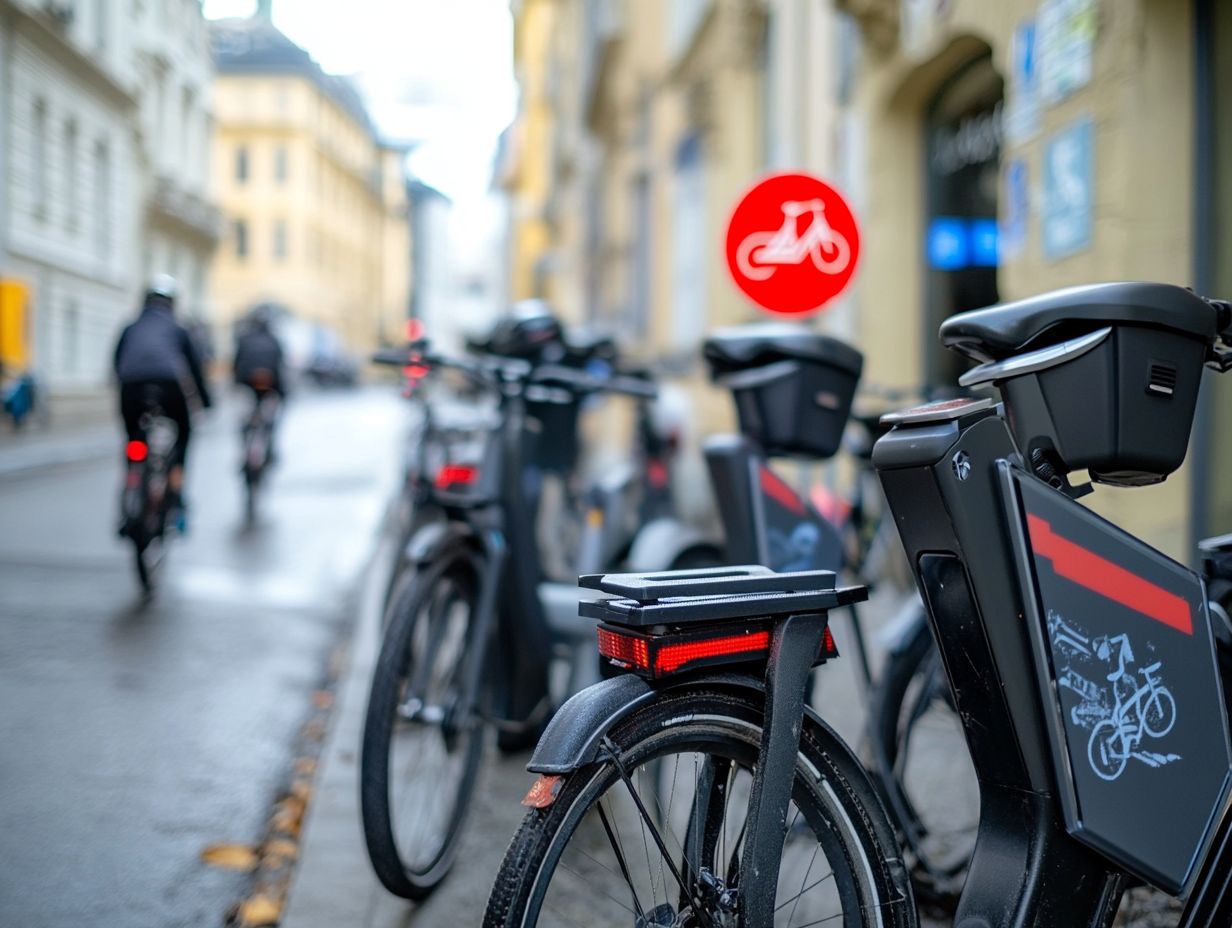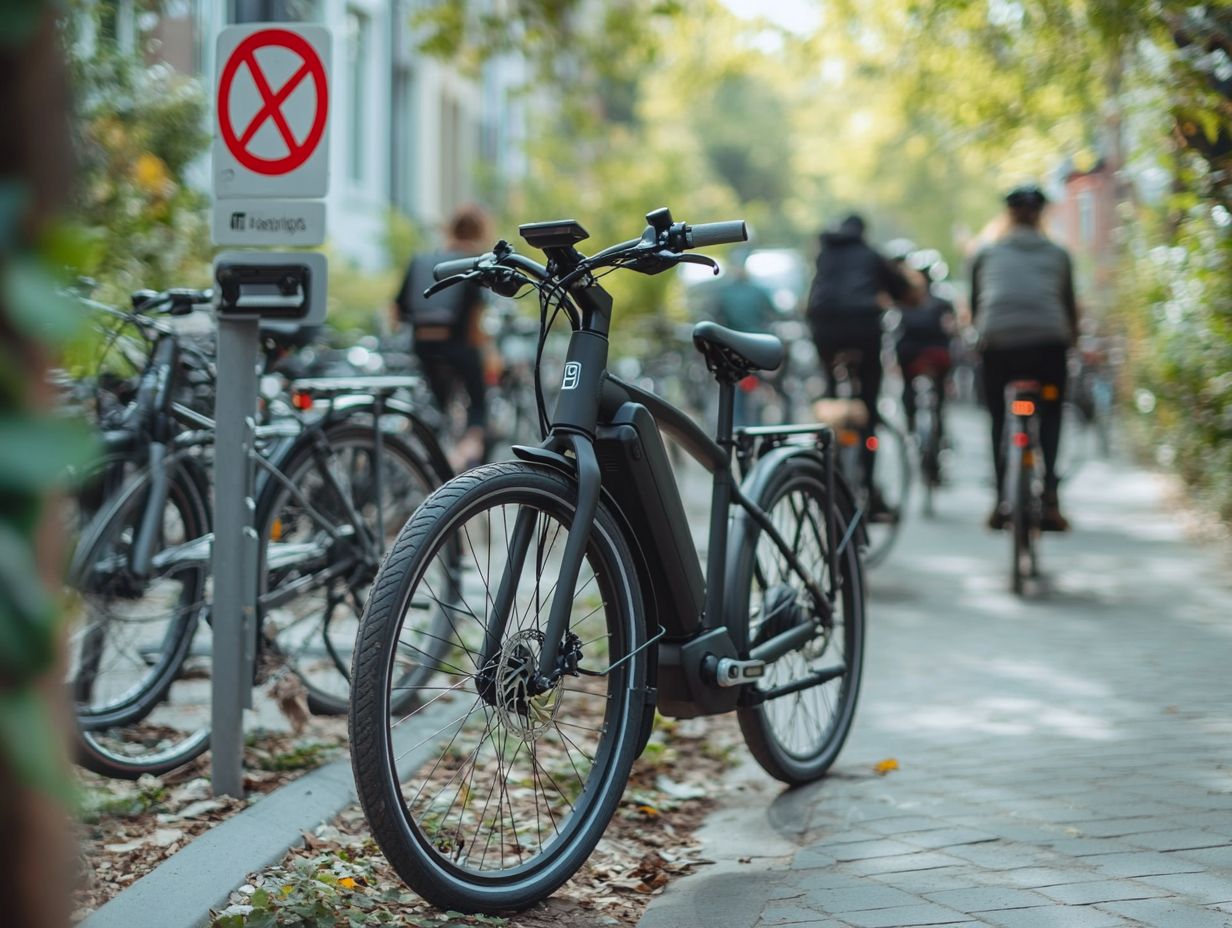The Most Important Electric Bicycle Laws to Remember
Electric bicycles are swiftly becoming a favored choice as a convenient and eco-friendly mode of transportation. Get ready to ride safely and legally! However, understanding the laws governing their use can be somewhat challenging.
From age restrictions and helmet regulations to speed limits and insurance mandates, grasping the legal landscape is crucial for every e-biker.
Discover the essential electric bicycle laws you need to know! This article outlines the most important rules, ensuring you ride both safely and legally. It also delves into the benefits and environmental impacts of electric bicycles, making it essential reading for both enthusiasts and newcomers alike.
Contents
- Key Takeaways:
- 1. Electric Bicycles Are Not Considered Motor Vehicles
- 2. Age Restrictions May Apply
- 3. Helmet Laws Still Apply
- 4. Speed Limits May Apply
- 5. Use of Bicycle Lanes and Paths
- 6. Riding Under the Influence
- 7. Registration and Licensing Requirements
- 8. Insurance Requirements
- 9. Safety Equipment Requirements
- 10. Rules for Riding on Sidewalks
- 11. Use of Hand Signals
- 12. Right-of-Way Rules
- 13. Restrictions on Carrying Passengers or Cargo
- 14. Restrictions on Modifying Electric Bicycles
- 15. Penalties for Violating Electric Bicycle Laws
- What Are the Benefits of Electric Bicycles?
- Frequently Asked Questions
- What are the most important electric bicycle laws to remember?
- Do I need a license to ride an electric bicycle?
- What traffic laws do I need to follow when riding an electric bicycle?
- Do I need to wear a helmet while riding an electric bicycle?
- Are there any age restrictions for riding an electric bicycle?
- Can I ride an electric bicycle on sidewalks or bike paths?
Key Takeaways:

- Electric bicycles are not considered motor vehicles, but there are still laws and regulations that riders must follow.
- Depending on your location, there may be age restrictions for riding an electric bicycle, so make sure to check local laws.
- Helmet laws still apply for electric bicycle riders, just like they do for traditional bicycle riders. Safety should always be a top priority.
1. Electric Bicycles Are Not Considered Motor Vehicles
Electric bicycles, commonly known as e-bikes, operate under a different classification than traditional motor vehicles. This distinction shapes the legal landscape regarding their use and regulation across states such as California, Florida, and New York, as well as at the federal level through organizations like PeopleForBikes and the Consumer Product Safety Commission.
Understanding these differences is crucial. E-bikes usually have lower speed limits and simpler licensing rules than traditional motor vehicles. For instance, while traditional motor vehicles require registration and insurance, many states allow e-bikes to operate without such requirements, provided they meet specific power output limits.
Regulations can differ significantly; some categorize e-bikes as bicycles as long as the motor doesn t exceed designated wattage. This allows you to enjoy cycling without being bogged down by more complex motor vehicle laws.
2. Age Restrictions May Apply
Age restrictions for riding electric bicycles can vary widely depending on your state and local authorities, influencing how young riders embark on their e-bike adventures.
In states like Texas, the minimum age is typically set at 15. In contrast, Massachusetts allows younger riders to hop on, acknowledging the trend of e-bikes as a popular choice for commuting and recreation among youth.
On the other hand, Alaska takes a more cautious approach, requiring anyone under 16 to wear a helmet, highlighting a strong commitment to safety.
These regulations ensure that riders possess necessary skills and understand the responsibilities of operating a powerful machine. For a detailed overview, check out the electric bicycle laws: a comparison between states. Each state’s perspective reflects its unique traffic safety policies and dedication to safeguarding young riders as they enjoy the freedom of e-bike journeys.
3. Helmet Laws Still Apply
Despite the rising popularity of electric bicycles, helmet laws remain crucial for biking safety, ensuring you are adequately protected while enjoying your e-bike experience.
Different states have their own regulations regarding helmet use, especially when differentiating between classes of e-bikes. In some areas, riders of Class 1 e-bikes which provide assistance only while pedaling might not be required to wear helmets. However, if you re on a Class 3 e-bike, known for higher speed capabilities, wearing a helmet is typically mandatory.
This variation underscores the importance of familiarizing yourself with local laws to establish safe riding habits. Research shows that wearing helmets can significantly lower the risk of severe head injuries, emphasizing their vital role in keeping you safe as you navigate crowded areas.
4. Speed Limits May Apply
Speed limits for electric bicycles hinge on their classification Class 1, Class 2, or Class 3 which dictates the motor assistance level and the maximum speed at which you can operate your eBike.
Understanding these classifications is crucial for both novice and seasoned riders. Each class has specific regulations that can change dramatically from one state or local jurisdiction to another.
For instance, Class 1 eBikes offer pedal-assist only and cap out at a maximum speed of 20 mph. They are often treated similarly to traditional bicycles in many areas. On the other hand, Class 2 models, equipped with a throttle and also limited to 20 mph, might encounter additional restrictions in certain regions.
Meanwhile, Class 3 eBikes can reach speeds of up to 28 mph with pedal-assist. They are subject to stricter regulations, including helmet requirements and constraints on where they can be ridden. These varying laws promote safe riding practices, reduce accidents, and create an accommodating environment for all cyclists sharing the road.
5. Use of Bicycle Lanes and Paths
The use of bicycle lanes and paths is essential to your eBike riding experience. Regulations governing access can differ significantly across states and local jurisdictions.
These laws dictate where you can ride your electric bicycle and establish classifications that might restrict certain types of eBikes from specific pathways. Many local governments categorize eBikes into various classes based on their speed and power.
This categorization could lead to restrictions on multi-use trails or dedicated bike lanes. While some areas welcome all eBikes, others may only permit lower-powered models to keep paths safe and accessible for everyone.
Understanding these nuances is crucial for you as an eBike enthusiast who wants to enjoy every ride while staying compliant with local regulations.
6. Riding Under the Influence
Riding electric bicycles while under the influence is governed by strict laws. These laws are similar to those for traditional vehicles, underscoring the importance of safety regulations for responsible eBike operation.
These regulations exist to safeguard not just the riders but also pedestrians and other road users. The repercussions for operating an eBike while impaired could lead to serious consequences, such as hefty fines, license suspensions, and even criminal charges.
Understanding the traffic laws that maintain order on the roads is vital for anyone who opts to ride. By adhering to these legal standards, you’ll contribute to a safer environment for yourself and everyone sharing the roadway, reinforcing the shared responsibility that comes with urban mobility.
7. Registration and Licensing Requirements

Registration and licensing requirements for electric bicycles differ significantly from state to state. This influences how you engage with your eBike and navigate the regulatory landscape.
Take Connecticut, for example. This state adopts a more relaxed legal framework, allowing for fewer restrictions on eBike usage, making it easier for you to enjoy your ride.
On the flip side, Maryland has taken a firmer stance. It implements stringent guidelines that require registration for higher-class eBikes and sets specific age limitations for riders.
These variations dictate not only how you operate your eBike but also shape community perceptions of eBike safety and their environmental benefits. Understanding these regulations is essential for you to enjoy your eBike fully while staying compliant with state laws.
8. Insurance Requirements
Insurance requirements for electric bicycles are becoming increasingly relevant due to potential liability issues that can arise during e-bike operation and accidents.
As the popularity of electric bikes continues to rise, it’s crucial to understand the various types of coverage available and how state-specific regulations can influence your insurance needs. Liability coverage protects you financially if you’re responsible for an accident, safeguarding against claims from collisions with other road users.
Keep in mind that some states require a minimum level of insurance, while others may not mandate it at all. Understanding these nuances, including electric bicycle safety regulations, will help you navigate the laws and rules confidently, allowing you to fully enjoy the freedom and convenience that electric bicycles offer.
9. Safety Equipment Requirements
Safety equipment requirements for electric bicycles are essential for ensuring your biking safety. Regulations may include lights, reflective gear, and other technologies designed to enhance your visibility and protection on the road.
In various states, these regulations can differ widely. Some may mandate specific helmet types, while others might require you to wear bright clothing or carry additional lighting for night rides. Implementing these safety measures is not just a legal requirement; it s vital for cultivating a culture of safe riding practices.
By following these guidelines, you can significantly reduce your risk of accidents and injuries, making your e-bike adventures enjoyable and secure. Understanding these state-specific electric bicycle legal frameworks is crucial for any cyclist navigating the complex rules surrounding electric bicycle use.
10. Rules for Riding on Sidewalks
The rules regarding riding on sidewalks can vary significantly between municipalities, with local authorities establishing specific regulations for electric bicycles that you must follow to ensure safety and compliance.
In some areas, e-bike riders are allowed to use sidewalks, while in others, you might be required to stick to the road. It’s essential to familiarize yourself with the intricacies of local legislation, as ignoring these rules can lead to consequences such as fines or increased accident risk.
With the growing popularity of e-bikes, understanding key legal considerations for electric bicycle riders creates a safer riding environment and nurtures better relationships between cyclists and pedestrians. Stay informed and mindful about where and how you ride!
11. Use of Hand Signals
Hand signals are crucial for biking safety, allowing clear communication between riders and drivers. This is especially important when operating an electric bicycle, as it enhances your e-bike experience on the roads.
These signals are essential for ensuring that both you and nearby vehicles can anticipate your movements, which reduces the risk of accidents. For example, extending your left arm sideways means you re making a left turn, while raising your right arm signifies a right turn.
Understanding these signals goes beyond etiquette; they are often required by local laws designed to protect cyclists. As an e-bike rider, familiarize yourself with these regulations and consistently use hand signals to create a safer riding environment. For more information, check out how to stay compliant with electric bicycle laws. This way, everyone can enjoy the road responsibly.
12. Right-of-Way Rules
Understanding right-of-way rules is essential for you as an e-bike rider, as these regulations dictate how your electric bicycle should interact with other road users and maintain safe traffic flow.
Navigating the roads with confidence requires familiarizing yourself with these rules, which can differ from those that apply to traditional bicycles. For instance, specific traffic laws may govern your speed limits and lane usage, making it vital to be aware of local regulations, including understanding electric bicycle laws in California.
Unlike standard bikes, your e-bike might be restricted from certain bike paths or designated areas based on state or city ordinances. To better understand these regulations, check out 5 essential questions about e-bike laws. Always remember to yield to pedestrians and stay alert to traffic signals to contribute to a safe and harmonious environment on the road.
13. Restrictions on Carrying Passengers or Cargo
Restrictions on carrying passengers or cargo on electric bicycles can differ significantly depending on state and local regulations, which shape how you use your e-bike for transportation.
These regulations are designed to keep you and others safe on the road. In many areas, e-bikes are limited to a single rider, with some places explicitly banning additional passengers or large cargo loads. For a comprehensive overview, check out the electric bicycle path regulations. This helps maintain a balance of weight and stability, which reduces the risk of accidents.
Safety features, such as efficient braking systems and proper lighting, enhance visibility and control. These features offer you added protection as you navigate both urban landscapes and rural paths.
14. Restrictions on Modifying Electric Bicycles

Restrictions on modifying electric bicycles exist to ensure safety and compliance with federal guidelines, which directly affect how you can customize your e-bike.
These regulations protect you and other road users by clearly defining what qualifies as a legal e-bike. Modifications, such as increasing speed limits or changing components, can unintentionally reclassify your bike from a regulated e-bike to a more restricted vehicle. This raises safety concerns, as improper modifications can lead to handling issues and exposes you to potential legal repercussions. To ensure you’re informed, check out the top 5 electric bicycle laws every rider should know.
Understanding these guidelines is crucial for anyone looking to enhance their ride while staying within the law.
15. Penalties for Violating Electric Bicycle Laws
Penalties for violating electric bicycle laws can vary widely, ranging from fines to the confiscation of your e-bike, depending on the severity of the infringement and local authorities’ regulations.
For instance, riding without a required helmet or exceeding speed limits could result in monetary fines aimed at discouraging unsafe practices. If you repeatedly break the rules, consequences may escalate, leading to loss of riding privileges or even mandatory safety courses.
These penalties help enforce rules and enhance the overall safety for both cyclists and pedestrians. By following local laws, you contribute to a safer environment on the roads, fostering a more responsible biking culture.
What Are the Benefits of Electric Bicycles?
Electric bicycles are a great eco-friendly option! They provide a versatile and efficient alternative to traditional cycling and motor vehicles, especially in today s urbanized landscape.
E-bikes help you reduce your carbon footprint by replacing short car trips that significantly contribute to air pollution. They also promote better health through increased physical activity. E-bikes make longer distances more manageable, encouraging more people to cycle, leading to improved cardiovascular fitness and overall wellness.
On an economic level, cities embracing e-bike initiatives can lower infrastructure costs associated with road maintenance, often exacerbated by heavier vehicles. As more individuals choose cycling for their daily commutes, businesses in urban areas thrive, ultimately cultivating a more sustainable urban environment.
What Are the Different Types of Electric Bicycles?
Electric bicycles are a diverse bunch, categorized into three main types Class 1, Class 2, and Class 3 each tailored to suit various riding preferences and regulatory frameworks.
Class 1 bicycles offer a pedal-assist feature that kicks in up to 20 mph. This makes them perfect for leisurely rides along bike paths and roads. If you enjoy a relaxed outing, this is your go-to choice.
Class 2 options come equipped with a throttle mechanism, allowing you to cruise without pedaling. This appeals to riders seeking a more effortless journey or those who appreciate a bit of extra support.
Class 3 models deliver assistance that can soar up to 28 mph ideal for commuters and enthusiasts eager to navigate bustling streets efficiently.
By grasping these distinctions, you can confidently select the e-bike that aligns with your needs and the legal parameters of your intended riding areas.
How Do Electric Bicycles Differ from Traditional Bicycles?
Electric bicycles stand apart from traditional bicycles mainly because of the innovative e-bike technology that delivers motor assistance, significantly enhancing your riding experience.
This motor assistance gives you the power to conquer hills and tackle longer distances with remarkable ease. This feature is particularly enticing if you find conventional cycling a bit taxing.
In terms of speed, e-bikes often boast faster speeds, facilitating quicker commutes or leisurely rides without the fatigue that typically accompanies pedaling solo.
When navigating diverse terrains, electric bicycles truly excel. They provide additional torque and support that allows you to confidently traverse challenging landscapes, whether you’re facing steep inclines or rugged roads.
With such impressive features, e-bikes emerge as a versatile choice, perfectly suited for both leisurely outings and practical transportation needs.
What Are the Environmental Impacts of Electric Bicycles?
Electric bicycles offer remarkable environmental benefits, positioning themselves as a premium transportation alternative that significantly reduces your carbon footprint and fosters greener urban mobility.
These cutting-edge vehicles play a pivotal role in creating a cleaner atmosphere by dramatically lowering harmful gases that contribute to pollution compared to traditional gasoline-powered vehicles.
In bustling cities where traffic congestion is the norm, embracing electric bicycles can ease gridlock. They take up less space on the road and can effortlessly maneuver through tight spots.
By replacing short car trips which often involves frustrating stops and starts with electric bicycles, you cut down on fossil fuel consumption and elevate the overall quality of urban life.
This transition to cleaner transportation not only nurtures a healthier environment but also encourages a more active lifestyle among commuters like you.
How Can Electric Bicycles Help with Commuting?
Electric bicycles provide unmatched convenience for your daily commute. They allow you to navigate urban landscapes with ease while reaping the benefits of physical activity and cutting down your travel time.
Utilizing an electric bicycle can tremendously simplify your daily routine, enabling you to bypass traffic jams and reach your destinations in record time. Imagine gliding past traffic as a commuter; with an electric bike, you could dramatically reduce that travel time and arrive at your destination feeling invigorated instead of frazzled!
Unlike traditional transport options that come with ongoing expenses like fuel and parking fees, electric bicycles demand minimal maintenance and offer lower operational costs. This makes them a smart and economical choice for your everyday travel.
The gentle exercise you get boosts your physical health and enhances your mental well-being, delivering a win-win scenario for those who opt for this eco-friendly mode of transport in their daily journeys.
Frequently Asked Questions

What are the most important electric bicycle laws to remember?
Key laws for riding electric bicycles include having a valid driver’s license, following traffic laws, and wearing a helmet. Be aware of local laws and federal guidelines that apply to electric bicycles.
Do I need a license to ride an electric bicycle?
Yes, you need a valid driver’s license to ride an electric bicycle on public roads in most states. You must also follow e-bike rules in regions like California and Florida.
What traffic laws do I need to follow when riding an electric bicycle?
Follow all traffic laws, such as stopping at stop signs and traffic lights, signaling when turning, and riding in designated bike lanes or on the right side of the road. Always remember the speed limits for electric bicycles.
Do I need to wear a helmet while riding an electric bicycle?
In many states, helmets are required for riders under a certain age or when riding at certain speeds. Wearing a helmet is a smart move to keep you safe!
Are there any age restrictions for riding an electric bicycle?
Yes, age restrictions vary by state. In some states, riders must be at least 16 years old to ride an electric bicycle. Check your local laws for details.
Can I ride an electric bicycle on sidewalks or bike paths?
Electric bicycles are often prohibited on sidewalks but may be allowed on certain bike paths. Always check local laws and signage before riding on sidewalks or bike paths. Many municipalities have specific multi-use trails for e-bike access.





